Finally, Coco is playing everywhere, and I am so excited that this movie is doing so well. It’s one thing to make a lot of money at the box office, but it’s so much more important- at least in my opinion- to make a movie that touches people. Those are the movies that I want to share with my family; the ones that I will continue to revisit at different stages in my life and my children’s lives. Coco is absolutely one of those movies.
This movie has so much heart because it was made with a lot of love. Mexican culture is not shown very often in mainstream American media, and this was a fantastic opportunity for that to change. Because of the importance of this opportunity, Director Lee Unkrich, Writer & Co-Director Adrian Molina and Producer Darla K. Anderson put so much work into this film and it absolutely paid off! Hear what they had to say about getting the story right, paying tribute to those who have inspired them, and more!
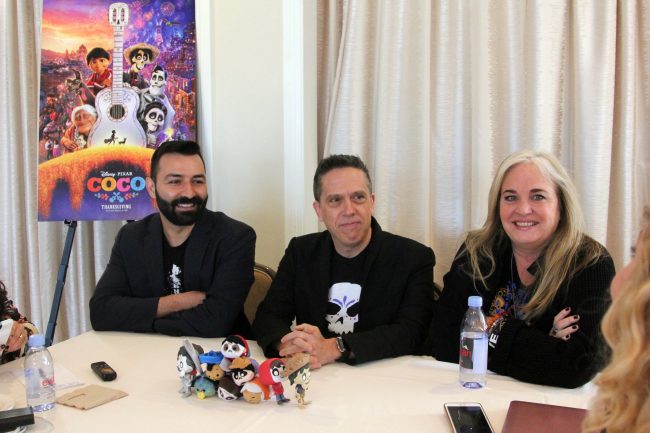
Why do you like making us cry so much?
Lee Unkrich: I don’t know that I like making you cry, but I like making you feel something. I know that when I go and see movies, they’re very few and far between where I actually feel genuine emotion or a movie really sticks with me after I’ve seen it. So, when we make our movies we try to do that. There’s no guarantee that we’ll be able to, but I think that’s the most satisfying for us if we can have the audience feel something personal to themselves, and we know we’re on the right track when we have those feelings ourselves.
It’s hard when we’re making the film over the course of six years. You’ll have an idea – like we had the idea for Miguel to sing to mama Coco [SPOILER REMOVED!]. It was in our first screening I think, and I think we were all very affected that first time that we put it together. But, it was then years afterwards that we continued to refine the movie and change the story leading up to that point, and we had to just trust in that initial feeling that we had when we first put that scene up, and try to hold on to that and make sure that many years later when he were actually animating the scene that it hopefully would still have the effect on other people that it had on us initially.
Darla K. Anderson: But in order to feel all those feelings, you’ve had to go on a journey with all of our characters, and you’ve had to laugh with them and be on big adventure with them, and become completely invested with them. We have to earn all of that emotion. So, it comes out of a multitude of the emotions from the movie.
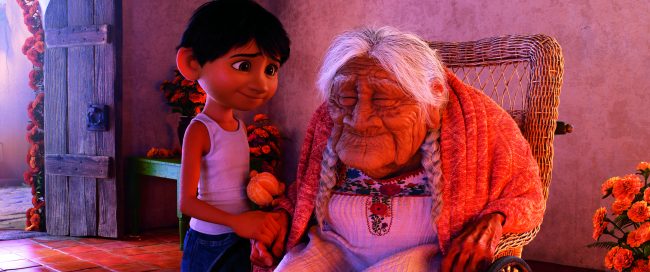
Were you guys in the land of the dead as well?
Adrian Molina: There are only two cameos of actual living people in the film. One is Michael Giacchino, and the other is our music consultant, Camilo Lara, who plays the DJ at the party.
Lee Unkrich: Adrian and I both have a line in the movie. I always like to have a cameo, not physically, but just my voice. So, I’m the guy who says, “What did I miss?” at the end.
Adrian Molina: And then, after Miguel takes the guitar and the light comes in on the window, I’m the one, “The guitar, it’s gone!”
There were two cameos of those who are living. Are those some who have passed over?
Lee Unkrich: Yeah, we tried to fill the film with as many famous Mexican celebrities as we could. Some of which we knew would be recognizable for general audiences, but some we knew only people who grew up in Mexico would know. People like Pedro Infante and Jorge Negrete and Cantinflas, Maria Felix, El Santo of course, Esquivel… Juan Carlos Esquivel is the guy who’s playing the glass harmonica before the talent show. You know, he’s the glasses. He’s a quirky, kind of semi-well known Mexican musician. Of course, Diego Rivera and Frida Khalo.
Adrian Molina: So much of that was inspired by the fact that we’ve got this once in a lifetime opportunity to have characters literally go into history, and Miguel is this kid who wants so much to use his music to connect, but he doesn’t have the role models to be able to help him on that path, so what a wonderful opportunity to lean on these Mexican icons who used their art to change the world, and let them be the kind of characters that inspire him and push him to use his art to do beautiful things. I’m so happy that this is the one film where you can do that in such an intuitive way.
Lee Unkrich: Yeah. We were always striving to make a film that felt kind of timeless. It’s kind of set know, but I’m hoping that it will always feel like it’s kind of set now. No matter when people see it. I remember when I was a kid after school watching Warner Brothers cartoons, like Bugs Bunny, and every once in a while one would pop up that would be full of people I didn’t recognize, they’d have like a scene in a bar and there’d be Edward G. Robinson and, like a lot of movie stars from that time that I didn’t know who they were, but I knew they were somebody famous at some time. It just felt that doing this in this film also felt like a little nod to kind of the history of animation in having kind of caricatured cameos of well-known people.
Darla K. Anderson: But they were so totally entertaining when you were a kid. It didn’t matter that you didn’t know who they were.
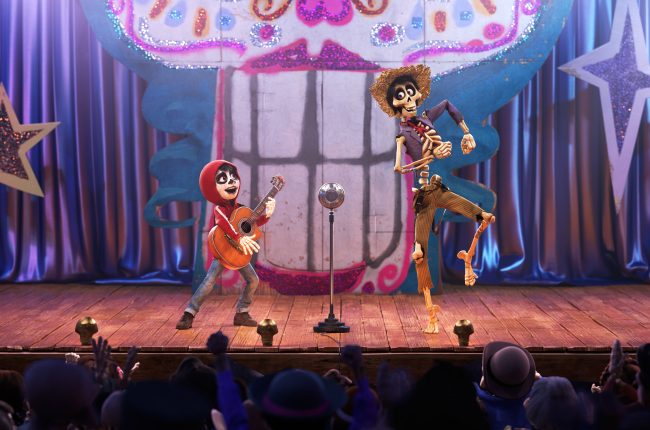
Was it a decision from the beginning to have an all Latino cast?
Lee Unkrich: Yeah, absolutely. It was non-negotiable. I mean, we knew we had to put John Ratzenberger in the movie.
Darla K. Anderson: We’re not breaking the spell.
Lee Unkrich: It was very important to us, and it was the right thing to do. It would have been very strange to not. And it didn’t make casting a challenge; it definitely narrowed the options.
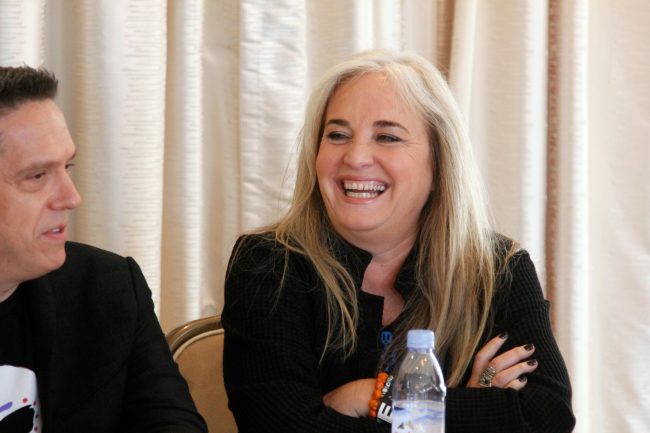
Coco premiered in Mexico. How important was that to you guys?
Darla K. Anderson: Oh it was really important.
Adrian Molina: Yeah it was, we try to talk as much as we can about how much research that we did on this film, and part of the effect that that research had on us wasn’t just on the story. It was the fact that we were meeting these families and we were making these friends, and we were collaborating with artists all over Mexico. And the least we could do to pay homage to the beauty of the tradition and the place where they came from; we were just over the moon to have the opportunity to premiere in Mexico, especially in Mexico City at the Palace of Fine Arts.
It’s like, who gets that opportunity?! And the level of love and engagement from that audience and from the country ever since.
Lee Unkrich: It’s been a little overwhelming.
Adrian Molina: It’s been very overwhelming in the most beautiful way. But it just felt like all we could do to say, “Thank you so much for opening your hearts, opening the doors,” and maybe a gesture on our part to say what a beautiful tradition, this is where it comes from everyone, take notice.
Assuming you didn’t celebrate The Day of the Dead as a child, what is something you have learned throughout your research and making this film that is the most dear to your heart?
Lee Unkrich: Well, I knew a fair amount about the tradition before I started this, but I then learned way more, of course, in the course of making it, and one thing that I didn’t know that we learned early on is this belief that we’re all capable of kind of dying multiple deaths. The actual belief is that we all die the first time when our heart stops. Then we die a second time when we’re buried and no one can ever see us again. But then there was this idea of this third and final death, when there’s nobody left among the living who remembers us and who can tell our stories.
That was then kind of the final death. That was a whole notion that I had never heard of before diving into this. And, once we all heard it, it just was clear to us that it was incredibly poignant and needed to be an important part of the story that we were telling.
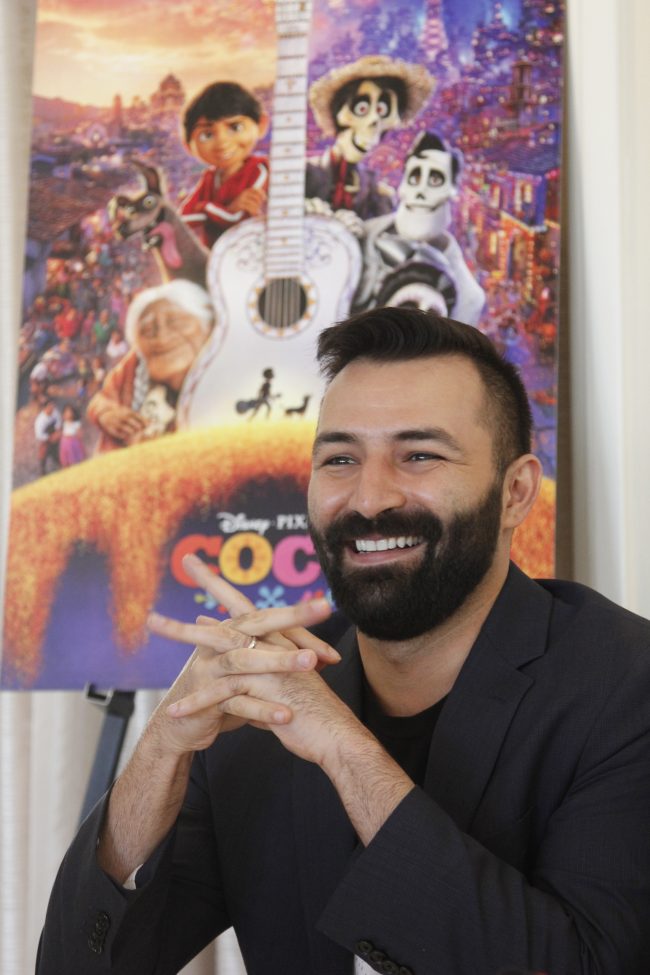
What was the biggest challenge when trying to get the story right?
Adrian Molina: There’s a lot of pieces to this story, and I think when you’re watching it the first time through, a lot of them can be hidden, and that’s by design. But there’s a very certain order to what the characters know about each other and what they say to each other, and who’s in the room when. And it just took a lot of iteration to figure out how to put these puzzle pieces together. On top of that, there’s the fact that this is a tradition that a certain portion of the audience is going to be very familiar with, and then another very large portion is going to have no idea. And it took a while to figure out, how do we invite people in, who aren’t familiar, without slowing down too much for the people who are?
It took a while to find, but it ultimately came down to, the way this tradition is transmitted is through the family, so Abuelita to Papa to be the ones who can convey this tradition to Miguel, at the same time as doing it for the audience and that became a very natural way to get people understanding why this is important to the culture and to the family.
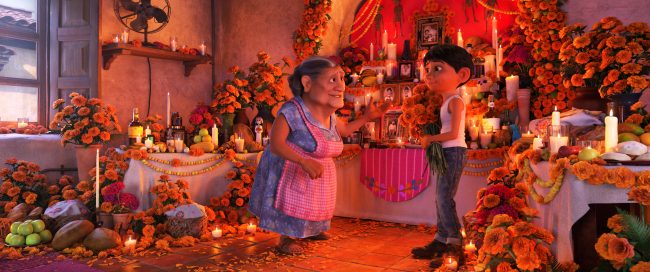
I’d love to know a little bit more about the pictures at the end. [After the end credits, the screen fills with photos of dozens of people as a tribute.]
Lee Unkrich: I had an idea at some point that I thought it would be lovely to do some sort of digital ofrenda at the end of the film because we had learned so much about the traditions and we had incorporated them into our lives at Pixar. For the second year now we’ve created a big ofrenda in the atrium of Pixar, and we’ve invited everyone in the company to bring in photos of their loved ones to put on the ofrenda, and I just had this thought, wouldn’t it be lovely to thank all the people that supported us, and continue to support us across time?
So we ended up extending the opportunity to everyone in the company to submit a photo of somebody who they had lost who was important to them, and we did that. My grandmother’s in there.
Darla K. Anderson: My mom.
Adrian Molina: My grandparents.
Lee Unkrich: And we also put a lot of people that we’ve lost over time. Different animators that we’ve lost unfortunately. Walt Disney is in there, Steve Jobs is in there. We put Don Rickles on there because we lost him this year; he was a big part of our family at Pixar. I regret that it’s at the end of the credits because I think that a lot of people won’t see it because a lot of people don’t stay for credits. But for the people who do, I think it will be very meaningful for them, and it’s very meaningful for us. It’s a very personal reflection of thanks to everyone who’s been there for us.
Disney Pixar’s Coco is playing in theaters right now! Don’t miss these printable Coco coloring pages and activity sheets, and be sure to catch my interviews with other stars from the film!

